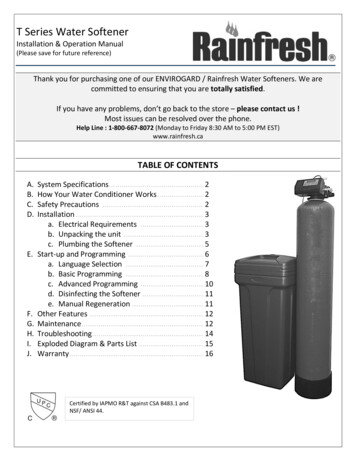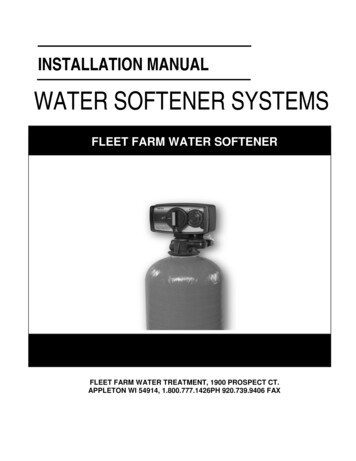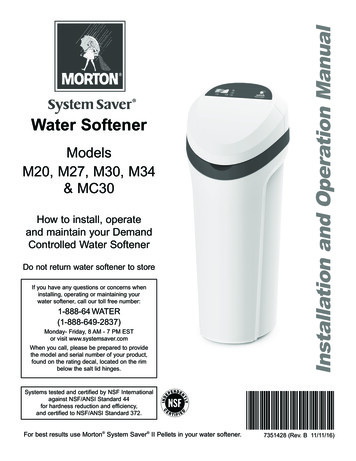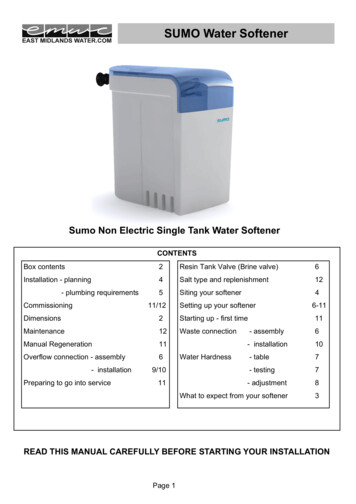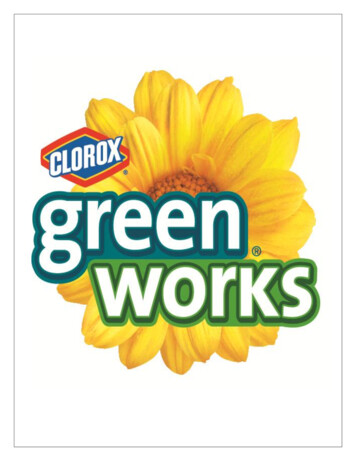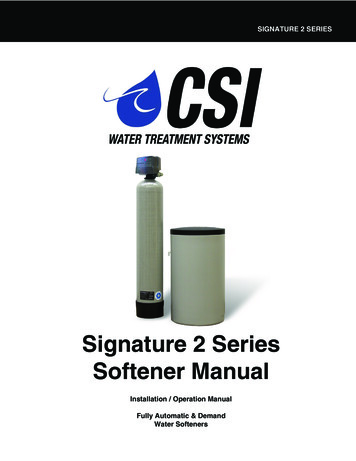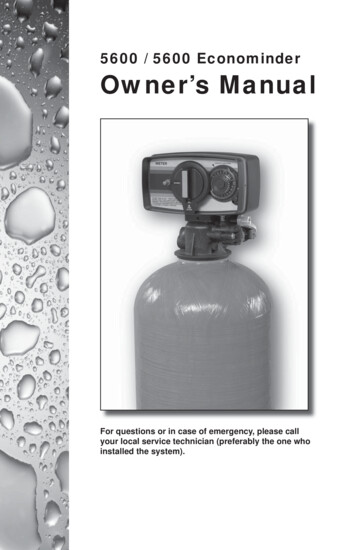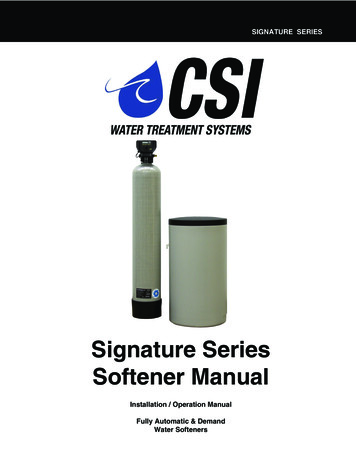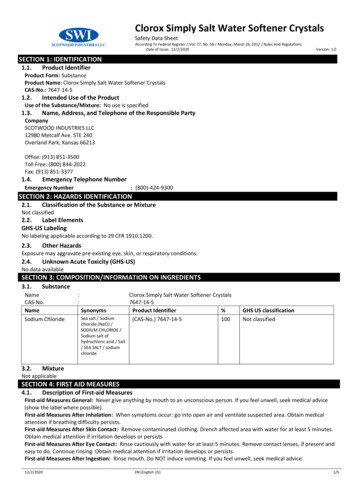
Transcription
Clorox Simply Salt Water Softener CrystalsSafety Data SheetAccording To Federal Register / Vol. 77, No. 58 / Monday, March 26, 2012 / Rules And RegulationsDate of Issue: 12/2/2020Version: 1.0SECTION 1: IDENTIFICATION1.1.Product IdentifierProduct Form: SubstanceProduct Name: Clorox Simply Salt Water Softener CrystalsCAS-No.: 7647-14-51.2.Intended Use of the ProductUse of the Substance/Mixture: No use is specified1.3.Name, Address, and Telephone of the Responsible PartyCompanySCOTWOOD INDUSTRIES LLC12980 Metcalf Ave. STE 240Overland Park, Kansas 66213Office: (913) 851-3500Toll Free: (800) 844-2022Fax: (913) 851-33771.4.Emergency Telephone NumberEmergency Number: (800)-424-9300SECTION 2: HAZARDS IDENTIFICATION2.1.Classification of the Substance or MixtureNot classified2.2.Label ElementsGHS-US LabelingNo labeling applicable according to 29 CFR 1910.1200.2.3.Other HazardsExposure may aggravate pre-existing eye, skin, or respiratory conditions.2.4.Unknown Acute Toxicity (GHS-US)No data availableSECTION 3: COMPOSITION/INFORMATION ON INGREDIENTS3.1.SubstanceNameCAS-No.NameSodium Chloride3.2.::SynonymsSea salt / Sodiumchloride (NaCl) /SODIUM CHLORIDE /Sodium salt ofhydrochloric acid / Salt/ SEA SALT / sodiumchlorideClorox Simply Salt Water Softener Crystals7647-14-5Product Identifier%(CAS-No.) 7647-14-5100GHS US classificationNot classifiedMixtureNot applicableSECTION 4: FIRST AID MEASURES4.1.Description of First-aid MeasuresFirst-aid Measures General: Never give anything by mouth to an unconscious person. If you feel unwell, seek medical advice(show the label where possible).First-aid Measures After Inhalation: When symptoms occur: go into open air and ventilate suspected area. Obtain medicalattention if breathing difficulty persists.First-aid Measures After Skin Contact: Remove contaminated clothing. Drench affected area with water for at least 5 minutes.Obtain medical attention if irritation develops or persists.First-aid Measures After Eye Contact: Rinse cautiously with water for at least 5 minutes. Remove contact lenses, if present andeasy to do. Continue rinsing. Obtain medical attention if irritation develops or persists.First-aid Measures After Ingestion: Rinse mouth. Do NOT induce vomiting. If you feel unwell, seek medical advice.12/2/2020EN (English US)1/5
Clorox Simply Salt Water Softener CrystalsSafety Data SheetAccording to Federal Register / Vol. 77, No. 58 / Monday, March 26, 2012 / Rules and Regulations4.2.Most Important Symptoms and Effects Both Acute and DelayedSymptoms/Injuries: Not expected to present a significant hazard under anticipated conditions of normal use.Symptoms/Injuries After Inhalation: Prolonged exposure may cause irritation.Symptoms/Injuries After Skin Contact: Prolonged exposure may cause skin irritation.Symptoms/Injuries After Eye Contact: May cause slight irritation to eyes.Symptoms/Injuries After Ingestion: Ingestion may cause adverse effects.Chronic Symptoms: None expected under normal conditions of use.4.3.Indication of Any Immediate Medical Attention and Special Treatment NeededIf exposed or concerned, get medical advice and attention. If medical advice is needed, have product container or label at hand.SECTION 5: FIRE-FIGHTING MEASURES5.1.Extinguishing MediaSuitable Extinguishing Media: Water spray, fog, carbon dioxide (CO 2), alcohol-resistant foam, or dry chemical.Unsuitable Extinguishing Media: Do not use a heavy water stream. Use of heavy stream of water may spread fire.5.2.Special Hazards Arising From the Substance or MixtureFire Hazard: Not flammable.Explosion Hazard: Product is not explosive.Reactivity: Hazardous reactions will not occur under normal conditions.5.3.Advice for FirefightersPrecautionary Measures Fire: Exercise caution when fighting any chemical fire.Firefighting Instructions: Use water spray or fog for cooling exposed containers.Protection During Firefighting: Do not enter fire area without proper protective equipment, including respiratory protection.Hazardous Combustion Products: None known.SECTION 6: ACCIDENTAL RELEASE MEASURES6.1.Personal Precautions, Protective Equipment and Emergency ProceduresGeneral Measures: Avoid prolonged contact with eyes, skin and clothing. Avoid breathing dust.6.1.1.For Non-Emergency PersonnelProtective Equipment: Use appropriate personal protective equipment (PPE).Emergency Procedures: Evacuate unnecessary personnel.6.1.2.For Emergency PersonnelProtective Equipment: Equip cleanup crew with proper protection.Emergency Procedures: Upon arrival at the scene, a first responder is expected to recognize the presence of dangerous goods,protect oneself and the public, secure the area, and call for the assistance of trained personnel as soon as conditions permit.Ventilate area.6.2.Environmental PrecautionsPrevent entry to sewers and public waters.6.3.Methods and Materials for Containment and Cleaning UpFor Containment: Contain solid spills with appropriate barriers and prevent migration and entry into sewers or streams.Methods for Cleaning Up: Clean up spills immediately and dispose of waste safely. Recover the product by vacuuming, shovelingor sweeping. Transfer spilled material to a suitable container for disposal. Contact competent authorities after a spill.6.4.Reference to Other SectionsSee Section 8 for exposure controls and personal protection and Section 13 for disposal considerations.SECTION 7: HANDLING AND STORAGE7.1.Precautions for Safe HandlingPrecautions for Safe Handling: Wash hands and other exposed areas with mild soap and water before eating, drinking orsmoking and when leaving work. Avoid prolonged contact with eyes, skin and clothing. Avoid breathing dust.Hygiene Measures: Handle in accordance with good industrial hygiene and safety procedures.7.2.Conditions for Safe Storage, Including Any IncompatibilitiesTechnical Measures: Comply with applicable regulations.Storage Conditions: Keep container closed when not in use. Store in a dry, cool place. Keep/Store away from direct sunlight,extremely high or low temperatures and incompatible materials.Incompatible Materials: Strong acids. Alkali metals.7.3.Specific End Use(s)No use is specified12/2/2020EN (English US)2/5
Clorox Simply Salt Water Softener CrystalsSafety Data SheetAccording to Federal Register / Vol. 77, No. 58 / Monday, March 26, 2012 / Rules and RegulationsSECTION 8: EXPOSURE CONTROLS/PERSONAL PROTECTION8.1.Control ParametersFor substances listed in section 3 that are not listed here, there are no established exposure limits from the manufacturer,supplier, importer, or the appropriate advisory agency including: ACGIH (TLV), AIHA (WEEL), NIOSH (REL), or OSHA (PEL).8.2.Exposure ControlsAppropriate Engineering ControlsPersonal Protective Equipment: Suitable eye/body wash equipment should be available in the vicinity of anypotential exposure. Ensure adequate ventilation, especially in confined areas.Ensure all national/local regulations are observed.: Gloves. Protective clothing. Protective goggles.Materials for Protective ClothingHand ProtectionEye and Face ProtectionSkin and Body ProtectionRespiratory Protection:::::Other InformationChemically resistant materials and fabrics.Wear protective gloves.Chemical safety goggles.Wear suitable protective clothing.If exposure limits are exceeded or irritation is experienced, approved respiratoryprotection should be worn. In case of inadequate ventilation, oxygen deficientatmosphere, or where exposure levels are not known wear approved respiratoryprotection.: When using, do not eat, drink or smoke.SECTION 9: PHYSICAL AND CHEMICAL PROPERTIES9.1.Information on Basic Physical and Chemical PropertiesPhysical State: SolidAppearance: White crystalsOdor: No data availableOdor Threshold: No data availablepH: No data availableEvaporation Rate: No data availableMelting Point: No data availableFreezing Point: No data availableBoiling Point: No data availableFlash Point: No data availableAuto-ignition Temperature: No data availableDecomposition Temperature: No data availableFlammability (solid, gas): No data availableVapor Pressure: No data availableRelative Vapor Density at 20 C: No data availableRelative Density: No data availableSpecific Gravity: 2.16Density: 1.20 0.05 g/ml (bulk)Solubility: No data availablePartition Coefficient: N-Octanol/Water: No data availableViscosity: No data available9.2.Other Information No additional information availableSECTION 10: STABILITY AND eactivity: Hazardous reactions will not occur under normal conditions.Chemical Stability: Stable under recommended handling and storage conditions (see section 7).Possibility of Hazardous Reactions: Hazardous polymerization will not occur.Conditions to Avoid: Direct sunlight, extremely high or low temperatures, and incompatible materials.Incompatible Materials: Strong acids. Alkali metals.Hazardous Decomposition Products: Thermal decomposition generates: Hydrochloric acid. Disodium oxide.EN (English US)3/5
Clorox Simply Salt Water Softener CrystalsSafety Data SheetAccording to Federal Register / Vol. 77, No. 58 / Monday, March 26, 2012 / Rules and RegulationsSECTION 11: TOXICOLOGICAL INFORMATION11.1.Information on Toxicological EffectsAcute Toxicity (Oral): Not classifiedAcute Toxicity (Dermal): Not classifiedAcute Toxicity (Inhalation): Not classifiedSodium Chloride (7647-14-5)LD50 Oral Rat3550 mg/kg (Species: Wistar)LD50 Dermal Rabbit 10000 mg/kg (Species: New Zealand White)LC50 Inhalation Rat 42 g/m³ (Exposure time: 1 h)Skin Corrosion/Irritation: Not classifiedSerious Eye Damage/Irritation: Not classifiedRespiratory or Skin Sensitization: Not classifiedGerm Cell Mutagenicity: Not classifiedCarcinogenicity: Not classifiedReproductive Toxicity: Not classifiedSpecific Target Organ Toxicity (Single Exposure): Not classifiedSpecific Target Organ Toxicity (Repeated Exposure): Not classifiedAspiration Hazard: Not classifiedSymptoms/Injuries After Inhalation: Prolonged exposure may cause irritation.Symptoms/Injuries After Skin Contact: Prolonged exposure may cause skin irritation.Symptoms/Injuries After Eye Contact: May cause slight irritation to eyes.Symptoms/Injuries After Ingestion: Ingestion may cause adverse effects.Chronic Symptoms: None expected under normal conditions of use.SECTION 12: ECOLOGICAL INFORMATION12.1.ToxicityEcology - GeneralSodium Chloride (7647-14-5)LC50 Fish 1EC50 Daphnia 1LC50 Fish 2EC50 Daphnia 2NOEC Chronic Fish12.2.: Not classified.5560 (5560 – 6080) mg/l (Exposure time: 96 h - Species: Lepomis macrochirus [flowthrough])1000 mg/l (Exposure time: 48 h - Species: Daphnia magna)12946 mg/l (Exposure time: 96 h - Species: Lepomis macrochirus [static])340.7 (340.7 – 469.2) mg/l (Exposure time: 48 h - Species: Daphnia magna [Static])252 mg/l (Species: Pimephales promelas)Persistence and DegradabilitySodium Chloride (7647-14-5)Persistence and Degradability12.3.Not established.Bioaccumulative PotentialSodium Chloride (7647-14-5)Bioaccumulative Potential12.4.12.5.Not established.Mobility in Soil No additional information availableOther Adverse EffectsOther Information: No additional information available.SECTION 13: DISPOSAL CONSIDERATIONS13.1.Waste Treatment MethodsWaste Disposal Recommendations: Dispose of contents/container in accordance with local, regional, national, and internationalregulations.SECTION 14: TRANSPORT INFORMATIONThe shipping description(s) stated herein were prepared in accordance with certain assumptions at the time the SDS wasauthored, and can vary based on a number of variables that may or may not have been known at the time the SDS was issued.12/2/2020EN (English US)4/5
Clorox Simply Salt Water Softener CrystalsSafety Data SheetAccording to Federal Register / Vol. 77, No. 58 / Monday, March 26, 2012 / Rules and Regulations14.1.14.2.14.3.In Accordance with DOT Not regulated for transportIn Accordance with IMDG Not regulated for transportIn Accordance with IATA Not regulated for transportSECTION 15: REGULATORY INFORMATION15.1.US Federal RegulationsSodium Chloride (7647-14-5)Listed on the United States TSCA (Toxic Substances Control Act) inventory15.2.US State Regulations Neither this product nor its chemical components appear on any US state lists, or its chemicalcomponents are not required to be disclosed.SECTION 16: OTHER INFORMATION, INCLUDING DATE OF PREPARATION OR LAST REVISIONDate of Preparation or Latest RevisionOther Information: 10/07/2020: This document has been prepared in accordance with the SDSrequirements of the OSHA Hazard Communication Standard 29 CFR1910.1200This information is based on our current knowledge and is intended to describe the product for the purposes of health, safety andenvironmental requirements only. It should not therefore be construed as guaranteeing any specific property of the product.SDS US (GHS HazCom)False12/2/2020EN (English US)5/5
Suitable Extinguishing Media: Water spray, fog, carbon dioxide (CO 2), alcohol-resistant foam, or dry chemical. Unsuitable Extinguishing Media: Do not use a heavy water stream. Use of heavy stream of water may spread fire. 5.2. Special Hazards Arising From the Substance or Mixture Fire Hazard: Not flammable. Explosion Hazard: Product is not .
